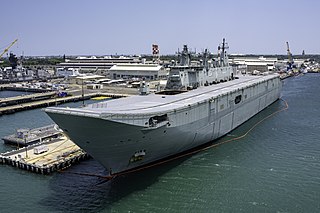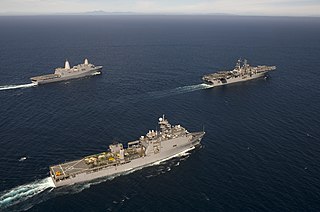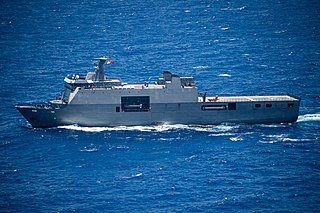
An aircraft carrier is a warship that serves as a seagoing airbase, equipped with a full-length flight deck and facilities for carrying, arming, deploying, and recovering aircraft. Typically, it is the capital ship of a fleet, as it allows a naval force to project air power worldwide without depending on local bases for staging aircraft operations. Carriers have evolved since their inception in the early twentieth century from wooden vessels used to deploy balloons to nuclear-powered warships that carry numerous fighters, strike aircraft, helicopters, and other types of aircraft. While heavier aircraft such as fixed-wing gunships and bombers have been launched from aircraft carriers, these aircraft have not landed on a carrier. By its diplomatic and tactical power, its mobility, its autonomy and the variety of its means, the aircraft carrier is often the centerpiece of modern combat fleets. Tactically or even strategically, it replaced the battleship in the role of flagship of a fleet. One of its great advantages is that, by sailing in international waters, it does not interfere with any territorial sovereignty and thus obviates the need for overflight authorizations from third-party countries, reduces the times and transit distances of aircraft and therefore significantly increases the time of availability on the combat zone.

The Albion-class landing platform dock is a class of amphibious warfare ship in service with the Royal Navy. The class consists of two vessels, HMS Albion and HMS Bulwark, ordered in 1996 to replace the ageing Fearless class. Both ships were built by BAE Systems Marine at the former Vickers Shipbuilding and Engineering yard in Barrow-in-Furness. Albion was commissioned in 2003 and Bulwark in 2004. Each of the ships has a crew of 325 and can accommodate up to 405 troops. Thirty-one large trucks and thirty-six smaller vehicles and main battle tanks can be carried inside the vehicle deck. To disembark troops and vehicles, the vessels are equipped with eight landing craft.

The Mistral class is a class of five amphibious assault ships built by France. Also known as helicopter carriers, and referred to as "projection and command ships", a Mistral-class ship is capable of transporting and deploying 16 NH90 or Tiger helicopters, four landing craft, up to 70 vehicles including 13 Leclerc tanks, or a 40-strong Leclerc tank battalion, and 450 soldiers. The ships are equipped with a 69-bed hospital, and are capable of serving as part of a NATO Response Force, or with United Nations or European Union peace-keeping forces.

The Galicia class are two landing platform dock (LPD) ships in service with the Spanish Navy. Built by Navantia at Ferrol, their mission is to carry out amphibious warfare by transporting the bulk of the Infantería de Marina. These ships have both a large helicopter flight deck and a 885-square-metre (9,530 sq ft) well deck for large landing craft, as well as a 1,000-square-metre (11,000 sq ft) space for up to 33 main battle tanks.

The Foudre-class landing platform dock is a class of landing platform docks designed and constructed for the French Navy. Designated Transport de Chalands de Débarquement, they were intended to replace the ageing Ouragan class and the construction of four vessels was planned. Only two were built and the remaining two were instead reordered as Mistral-class amphibious assault ships. The two ships of the Foudre class, Foudre and Siroco, operated with the French Navy between 1990 and 2014. Replaced by the Mistrals, in 2011 Foudre was sold to the Chilean Navy and Siroco was sold to the Brazilian Navy in 2015.

Juan Carlos I is a multi-purpose amphibious assault ship-aircraft carrier in the Spanish Navy. Similar in role to many aircraft carriers, the amphibious landing ship has a ski jump for STOVL operations, and is equipped with the McDonnell Douglas AV-8B Harrier II attack aircraft or the new Lockheed Martin F-35B Lightning II fighter aircraft. The vessel is named in honour of Juan Carlos I, the former King of Spain.
The Protecteur class of naval auxiliaries for the Royal Canadian Navy (RCN) began as the Joint Support Ship Project, a Government of Canada procurement project for the RCN that is part of the National Shipbuilding Procurement Strategy. It will see the RCN acquire two multi-role vessels to replace the earlier Protecteur-class auxiliary oiler replenishment vessels.
A joint support ship (JSS) is a multi-role naval vessel capable of launching and supporting joint amphibious and airlift operations. It can also provide command and control, sealift and seabasing, underway replenishment, disaster relief and logistics capabilities for combined land and sea operations.

The Kanimbla class was a class of amphibious transport ships operated by the Royal Australian Navy (RAN). Two ships were purchased by Australia in 1994 and modified. Problems during the handover process and the need to repair previously unidentified defects meant the ships did not enter operational service until the end of the decade.

The Canberra class is a ship class of two landing helicopter dock (LHD) ships built for the Royal Australian Navy (RAN). Planning to upgrade the navy's amphibious fleet began in 2000, based on Australian experiences leading the International Force for East Timor peacekeeping operation. With a new climate for growing Australian Navy spending, a desire existed for forward defence capability for landing and supporting troops on Asian territory, that had never existed in Australian history, even with the old Majestic-class light fleet carriers, HMAS Melbourne and HMAS Sydney in the 1970s. In 2004, French company Direction des Constructions Navales (DCN) and Spanish company Navantia were invited to tender proposals, with DCN offering the Mistral-class amphibious assault ship and Navantia proposing the "Buque de Proyección Estratégica" design. The Spanish design was selected in 2007, with Navantia responsible for construction of the ships from the keel to the flight deck, and BAE Systems Australia handling the fabrication of the combat and communications systems. Finally, Siemens (Germany) supplied and fitted the azimuth thrusters.

The Type 071 is a class of Chinese amphibious transport dock ships in service with the People's Liberation Army Navy (PLAN). The Type 071 provides the PLAN with capabilities and flexibility not found in its previous landing ships.

The San Giorgio class are amphibious transport docks (LPD) built by Fincantieri for the Italian Navy. These ships can carry a battalion of troops, and up to 36 armored vehicles. The stern floodable dock can accommodate three landing craft. The ships are based at the Brindisi naval base on the Adriatic coast.

An amphibious assault ship is a type of amphibious warfare ship employed to land and support ground forces on enemy territory during an amphibious assault. The design evolved from aircraft carriers converted for use as helicopter carriers. Modern designs support amphibious landing craft, with most designs including a well deck. Coming full circle, some amphibious assault ships also support V/STOL fixed-wing aircraft, now having a secondary role as aircraft carriers.

An amphibious warfare ship is an amphibious vehicle warship employed to land and support ground forces, such as marines, on enemy territory during an amphibious assault.

HMAS Canberra (L02) is the first ship of the Canberra-class landing helicopter dock in service with the Royal Australian Navy (RAN) and is the second largest in the Navy, succeeded by its sister ship HMAS Adelaide (L01). Construction of the ship started in Spain in 2008, with the hull launched by Navantia in 2011. The hull was then transported to Australia in late 2012 for completion by BAE Systems Australia. Canberra was commissioned on 28 November 2014.

HMAS Adelaide (L01) is the second of two Canberra-class landing helicopter dock (LHD) ships of the Royal Australian Navy (RAN) and is the largest naval vessel ever built for Australia. Construction of the ship started at Navantia's Spanish shipyard with steel-cutting in February 2010. The ship was laid down in February 2011, and launched on 4 July 2012. Delivery to Australia for fitting out at BAE Systems Australia's facilities in Victoria was scheduled for 2013, but did not occur until early 2014. Despite construction delays and predictions, the ship was commissioned in December 2015.
The procurement of Landing Platform Docks (LPD) by the Indian Navy, formerly known as the "Multi-Role Support Vessel Program" (MRSV) - is an initiative of the Indian Navy (IN) to procure a series of landing platform docks, specific vessels dedicated to amphibious warfare, as part of the service's strategy to augment its capabilities of amphibious warfare, disaster-response, humanitarian assistance and auxiliary duties.

The Tarlac class are landing platform docks of the Philippine Navy meant for amphibious operations and transport duties in support of the Armed Forces of the Philippines. The class was initially called the "Strategic Sealift Vessel" before being formally named. The ships will also double as a support platform for Humanitarian and Disaster Relief (HADR) and Search & Rescue (SAR) operations.

The Philippine Navy is expecting the delivery of two new 124-meter landing platform docks acquired under its Landing Dock Acquisition Project under the Revised AFP Modernization Program's Horizon 2 phase covering years 2018 to 2022.















